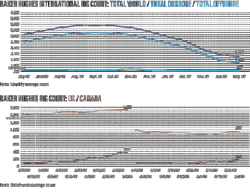From 1949 until 1973, the average annual price of oil fluctuated within a 7% band, but from 1981 through 2008 the variation leapt to almost 10 times that amount. The 1973 and 1979 oil crises and the sharp escalation and crash of oil prices between 1998 and 2009 introduced a new and seemingly systemic unpredictability to oil prices. The underlying cause is debatable; some think it is cyclical, and there is evidence that it could be chaotic. Certainly, a range of factors has contributed to the recent volatility, including political crises, financial speculation, and a sharp increase in demand from developing economies.1 2
Regardless of the reason behind the initial shocks, the variation from a steady-state historical demand induced the bullwhip effect—in which small changes in demand cause oscillating and increasing reverberations in production, capacity, and inventory—from 1995 to 2009 in markets for oil and gas field machinery and equipment, turbines and turbines generator sets, motors and generators, engine electrical equipment, iron castings, and steel.3
This article explains why bullwhip is such a problem, how much is costs, and how to dampen its impact through the use of collaborative planning and long-term supply commitments, thereby increasing the shareholder value of oil producers and their suppliers.
Bullwhip evidence
In the recent period of oil price volatility that began in 1998, oil drilling investment and activity have tracked the price of oil, and capital investment at some companies has exaggerated the swings in the price of oil. As the annual change in the price of oil fluctuated between –33% and +54%, the annual change in capital expenditure at major oil companies varied between –43% and +88%.4
The swings in capital investment by oil companies caused even bigger swings in the equipment supply chain, causing oscillation in production and inventory and backlog in the turbine and engine supply market.
While production of turbines declined by 7% (a small number), inventories rose by 24% (a lot higher number) between 1998 and 2008. In an analogous period when new orders spiked and fell three times in 12 years, the backlog of turbine generators tripled and then plummeted to nearly zero twice.5
This bullwhip effect causes four types of economic inefficiency at oil companies and their heavy equipment suppliers:
1. Oil companies pay higher prices that are set when markets are overheated and never rolled back when recession hits.
2. Equipment manufacturers hold excess inventory during the boom and take a long time to draw it down when the recession hits.
3. Equipment manufacturers make excessive capacity investments near the peak and then suffer a low or negative return on investment on it.
4. Component and parts suppliers lose orders that they are not able to fulfill at the peak due to inadequate capacity and long lead times caused by large backlogs.
The costs
The bullwhip effect costs $2 billion/year. When extrapolated to all oil and gas industry purchases, this "bullwhip tax" adds 10% to the cost of every barrel of oil produced. Equipment and component suppliers bear even more of the cost than oil companies.
Boston Strategies International Inc. (BSI) constructed a system dynamics simulation of two scenarios, one involving a flat oil price and the other a volatile oil price. In the flat oil price scenario, we simulated an initial shock and traced the aftereffects on the supply chain. In this case the initial shock was an increase in the price of oil from $30/bbl to $60/bbl. The price of oil rises to a peak of $90/bbl, drops to $30/bbl, and then rises back to $60/bbl to complete a sine wave, with a cycle of 20 years (the whole simulation lasted 43 years).
In the volatile oil price scenario, after the initial shock, oil price fluctuates in a sine wave with the same overall amplitude as under the smooth price cycle scenario but with random oscillation.
The simulation shows that over time supply chain costs are 10% higher as a result of the initial shock. Average annual supply chain costs over a 43-year period in a flat oil price scenario total $8.3 billion, while in the volatile oil price scenario they are $10.3 billion. The difference, $2 billion, spread across an 85 million b/d oil market, equates to roughly 6.4¢/bbl. Because turbines and compressors represent only 5.8% of oil companies' total external expenditure on equipment, materials, and services, the impact extrapolated to all equipment and services in the oil and gas supply chain is $1.09/bbl ($0.064/0.058). This is approximately 10% of the weighted average cost of producing a barrel of oil in 2008.6
Distribution of effects
Over an extended time, the initial increase in demand for oil raises the production levels of crude oil and refinery products, which translates into increased demand for oil field equipment such as oil and gas compressors and turbines. Excess output is higher at the refiner than at the producer, higher at the original equipment manufacturer (OEM) than at the refiner, and higher at the component supplier than at the OEM.
Refiners and producers pay higher prices that are set when markets are overheated and not de-escalated when recession hits. These price hikes add 5%/year to the cost of the equipment, materials, and services that operating companies buy, after adjusting for inflation caused by metals prices and pure commodity inputs.
Moreover, equipment and service prices keep rising even as the price of oil falls, equipment orders drop, capacity utilization drops 15%, and lead times decline to manufacturing throughput time. Capacity adjusts, with a lag, as orders and production fluctuate, which causes capacity utilization to fluctuate erratically. The annual cost for refiners is the highest under rough price scenario from years 8 to 17.
OEMs and other equipment makers (all called OEMs here) incur high costs in years 11 through 22 as orders grow due to rising oil prices, which causes OEMs to make excess capacity investments and pay high prices for components as those costs inflate as well. In fact, prices of turbine hot sections double over a 22-year period in the simulation. The capacity additions weigh heavily on the OEMs' finances as orders and backlog decline and bottom out, and the OEMs carry that excess capacity for 4 years too long (although to a lesser degree each year). The equipment manufacturers also hold excess inventory, which adds 8% to the cost of the equipment, similar to the way in which OEM manufacturers doubled their inventory between 2004 and 2008, which then became redundant when orders dropped off, and took 12 months to draw it down when the recession hit. Although rate of return was not modeled directly, related BSI studies show that the OEMs earn a 3% lower rate of return due to the dynamics of volatility.
Component suppliers lose orders on the upswing and hold excess inventory on the downswing. Component suppliers are the last ones to see backlogs decline due to their upstream role in the supply chain, and the approximate halving of their backlog amounts to a depletion of inventory. So, for most of the time during years 11 and 22, they are depleting inventory. This inventory carrying cost is their prime supply chain cost. Component and parts suppliers also lose orders that they were not able to fulfill at the peak due to inadequate capacity and long lead times caused by their large backlogs.
Mitigating costs
More than half of the oil and gas companies surveyed in a 2009 study by BSI said a stable pricing environment would help them establish steadier prices and operating profits.
Nearly as many said that it would minimize layoffs during downturns and rehiring during upturns, thereby reducing long-term operating costs. A third of them said it would allow more stable research and development (R&D) investments, which would result in higher exploration, refining, and distribution productivity due to faster and more-consistent advances in oil and gas equipment technology.
Smoothing volatility in demand and prices would result in steadier and more profitable capital expansion, which means a higher return on assets (ROA). Steadier prices would translate into higher operating profits and lower operating costs as companies would go through fewer waves of layoffs and subsequent rehiring. Perhaps most importantly, more-stable R&D investments would result in greater oil field productivity.
Governments can develop or enhance policies to regulate speculation in the futures markets to reduce volatility. In January, the US Commodity Futures Trading Commission (CFTC) made a formal proposal to limit certain financial intermediaries' use of futures for the purchase of certain types of crude oil, natural gas, and gasoline on two US exchanges. If enacted, this legislation could reduce the volatility in these markets, but it would not eliminate it. Traders will operate outside of the regulated exchanges, and other sources of volatility, such as geopolitical events, capacity imbalances, and even bad weather, will persist.
So, if government action won't cure the problem, and the satisfaction from crucifying the financial traders is short-lived, what can upstream and downstream oil companies and their equipment suppliers do? The basic strategies fall into two camps: "go short" and "go long."
Short and long
"Going short" (avoiding risk by passing all risk to suppliers) works well when demand is decreasing because the company adopting this policy can fully engage competition to drive prices lower in a buyer's market. However, it doesn't work very well when demand is increasing because the company is nobody's most important customer.
Despite its drawback, many if not most external purchases in the oil industry are managed on a short-term basis. For example, most power cable and industrial battery manufacturers that sell to oil companies routinely quote orders at spot market prices and absorb the risk of fluctuations in copper and lead prices between time of order and time of delivery.
Conversely, "going long" (making long-term commitments to suppliers) works well for the way up because the company can access capacity when nobody else can because it is somebody's most important customer. "Going long" works less well for the way down because the company may be paying higher prices than others for the guaranteed capacity, but it can engage suppliers in joint cost-savings and value engineering activities.
Several oil companies have demonstrated their faith in collaboration for the long term by establishing 10-year agreements with strategic suppliers, often locking in relationships that have already existed for a long time. A company doing this must remember that a supplier is strategic if there is a comparatively large amount of external expenditure on the supplier, if the planning and engineering time horizon of the projects is long, and if there is synergy between the buyer's and the supplier's businesses. Ultimately, the test of a strategic, rather than transactional, supplier is how much damage would be done if the supplier were removed.
A company choosing to "go long" must be sure to sign long enough agreements to bridge the up and down cycle. Many buyers think a long-term agreement is 3-5 years in duration. Because this is shorter than it takes for an initial demand disturbance to reverberate through the supply chain, the contract has a significant risk of painful and premature failure. BSI's recent work indicates that a company going long may need a much longer agreement in order to fully mitigate the impact of production-inventory capacity cycles. The exact length will depend on the category of purchased equipment or services.
Highly asset-intensive power generation and transportation companies have inked many long-term concession agreements that can serve as models.
Whether their contractual commitment is "long" or "short," buyers and suppliers in the oil and gas supply chain can mitigate the costs of the bullwhip effect (excess capacity, obsolete inventory, price inflation, and lost orders) by more tightly coordinating their demand and capacity planning activities. This could include, for example, 1) sharing production, sales, and inventory information among exploration and production companies, refiners, OEMS, and component manufacturers, 2) sharing supply risk by indexing prices and using options and futures contracts, and 3) sharing the risk of building new capacity by assuring minimum levels of usage or availability.
Acknowledgment
Zhuoyi Fan helped build and run the simulation model.
References
1. Asia's share of refinery throughput doubled from 14% to 28% between 1980 and 2008, according to BSI analysis of BP Statistical Review of World Energy, June 2009.
2. Two thirds of respondents to a 2009 Boston Strategies International survey felt that oil prices are caused by speculation by commodity traders and distortions in financial markets.
3. Boston Strategies International analysis of data from Global Insight.
4. Based on annual data.
5. Based on sales of the three largest turbine generator manufacturers between 1948 and 1962. From exhibit material, Ohio Valley Electric v. General Electric, Civil Action 62 Civ. 695, Second US District Court of New York, 1965.
6. Based on Boston Strategies International 2010 calculations of the all-in cost of purchased materials and services.
The author
More Oil & Gas Journal Current Issue Articles
More Oil & Gas Journal Archives Issue Articles
View Oil and Gas Articles on PennEnergy.com






